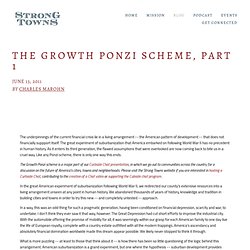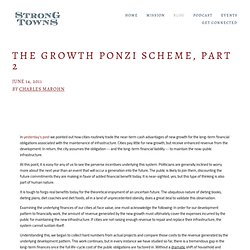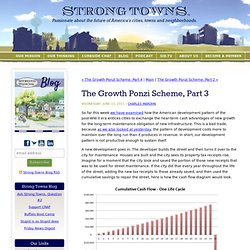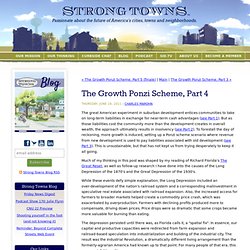

The Tragedy of Suburbia Permaculture Research Institute. How sprawl is like Bernie Madoff. The Growth Ponzi Scheme, Part 1. The underpinnings of the current financial crisis lie in a living arrangement -- the American pattern of development -- that does not financially suppport itself.

The great experiment of suburbanization that America embarked on following World War II has no precedent in human history. As it enters its third generation, the flawed assumptions that were overlooked are now coming back to bite us in a cruel way. Like any Ponzi scheme, there is only one way this ends. The Growth Ponzi scheme is a major part of our Curbside Chat presentation, in which we go out to communities across the country for a discussion on the future of America's cities, towns and neighborhoods. Please visit the Strong Towns website if you are interested in hosting a Curbside Chat, contributing to the creation of a Chat video or supporting the Cubside chat program.
In a way, this was an odd thing for such a pragmatic generation, having been conditioned on financial depression, scarcity and war, to undertake. The Growth Ponzi Scheme, Part 2. In yesterday's post we pointed out how cities routinely trade the near-term cash advantages of new growth for the long-term financial obligations associated with the maintenance of infrastructure.

Cities pay little for new growth, but receive enhanced revenue from the development. In return, the city assumes the obligation -- and the long-term financial liability -- to maintain the now-public infrastructure. At this point, it is easy for any of us to see the perverse incentives underlying this system. Politicians are generally inclined to worry more about the next year than an event that will occur a generation into the future. The public is likely to join them, discounting the future commitments they are making in favor of added financial benefit today. The Growth Ponzi Scheme, Part 3. So far this week we have examined how the American development pattern of the post-WW II era entices cities to exchange the near-term cash advantages of new growth for the long-term maintenance obligation of new infrastructure.

This is a bad trade, because as we also looked at yesterday, the pattern of development costs more to maintain over the long run than it produces in revenue. In short, our development pattern is not productive enough to sustain itself. A new development goes in. The developer builds the street and then turns it over to the city for maintenance. Houses are built and the city sees its property tax receipts rise.
Cash Flow Diagram for a single street. But a city is not one street. The cumulative cash flow of multiple projects in succession. So growth "solves" the insolvency problem. Here is what happens during that second life cycle. The Growth Ponzi Scheme, Part 4. The great American experiment in suburban development entices communities to take on long-term liabilities in exchange for near-term cash advantages (see Part 1).

But as those liabilities cost the community more than the development creates in overall wealth, the approach ultimately results in insolvency (see Part 2). To forestall the day of reckoning, more growth is induced, setting up a Ponzi scheme scenario where revenue from new development is used to pay liabilities associated with old development (see Part 3).
This is unsustainable, but that has not kept us from trying desperately to keep it all going. Much of my thinking in this post was shaped by my reading of Richard Florida's The Great Reset, as well as follow-up research I have done into the causes of the Long Depression of the 1870's and the Great Depression of the 1930's. The depression persisted until there was, as Florida calls it, a "spatial fix". Fast forward to the 1930's. Debt levels post WW II as compared to GDP. The Growth Ponzi Scheme, Part 5 (finale) There is a fine line one walks when doing a series like this, and I struggle with it myself.

On one side of the line, there is a tremendous problem we've identified, it has dramatic consequences that we are largely unaware of as a culture, and I want to yelp at the top of my lungs to make people aware. On the other side of the line is an awareness that the world does not want to listen to a sky-is-falling, doom-and-gloom, pessimist. We tend to call such people "crazy" and, in time, zone them out. In this regard, I am certain that some people felt my last comment yesterday was unnecessarily provocative. Our national economy is "all in" on the suburban experiment. I feel bad, but I am not trying to be provocative.
Let me pass on an analogy I have used here before. America is in a slow-motion car wreck. I wish I had one. For me, the rational response starts with this picture. This is my hometown as it appeared in 1894.